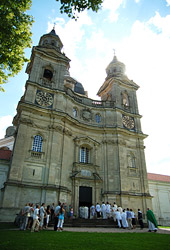Pažaislis Church
The Pažaislis church was built according to the latest architectural fashions of the time. The overall design recalls the centrally planned churches of Venice, while the two-tower façade and the dominating dome are more akin to the baroque structures of Rome and Northern Italy. The church was novel in two respects: its concave façade and its hexagonal central floor plan.
This was the first concave façade to be built in Europe. The concave part of the façade creates a strong visual impression, above all making the dome more conspicuous. The two massive towers on the façade, a popular architectural accent in Northern Italy, also serve to focus attention on the façade and dome. The other architectural novelty is the church’s hexagonal floor plan, an infrequent design that, when used at all, is generally used only for small structures like chapels. The builders of Pažaislis may have been inspired to choose this design by Venetian architectural trends.
Immediately upon entering the church, ones sight is drawn to the altar, with its painting of Our Lady of Fair Love. The central nave is bordered by tall columns which dominate the interior architecture of the church, emphasizing the verticality of its spaces. Further strengthening this effect is the skilful employment of marble of various colours. The scene of the Coronation of the Blessed Virgin Mary, surrounded by saints, is depicted in the fresco of the dome.
Four chapels, architecturally identical, lie beside the main nave. The side chapels nearest the entrance are dedicated to St Christopher and St Francis de Sales, patron saints of the monastery’s benefactors. The other two chapels are dedicated to St Romuald, the holy intercessor of the Camaldolese order, and St Maria Magdalen de Pazzi, patron of the Pacas family. Five frescos are painted in each chapel, two large ones on the walls and three smaller ones on the vault. Not all of the depicted scenes are recognizable, given that in some cases only fragments of the frescos remain. Each chapel contained an altar and several pictures, but these were destroyed during the 19th century.








